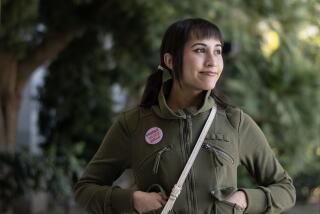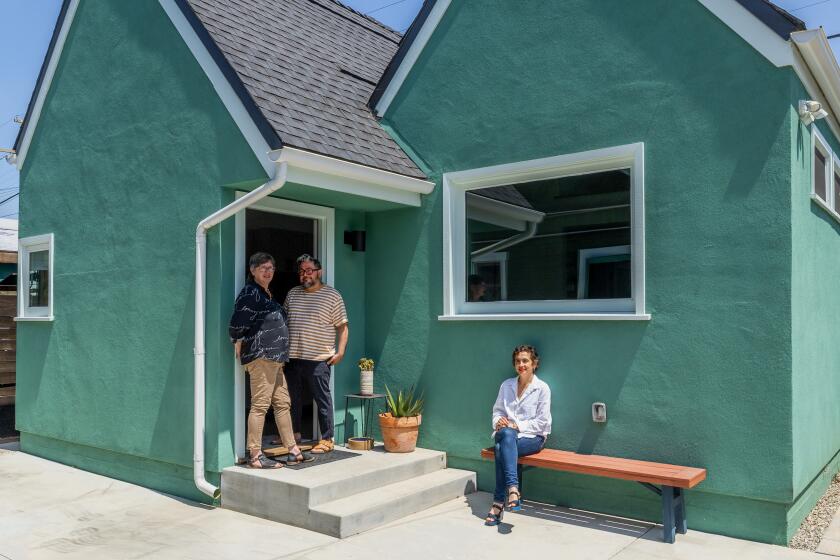Altar of History : 400-Year-Old Walnut Structure Is Installed in Chapel of Mission
In the chapel of San Fernando Mission its patron saint is welcomed into heaven by the Holy Trinity. A sculpted angel waits nearby, holding a heavenly crown on a pillow. The figure of St. Mary Magdalene stands to the right and to the left is Father Junipero Serra.
Carved nearly four centuries ago from blocks of walnut, the religious figures are part of a lavish altar installed this month that covers the entire east wall of the chapel. The altar, along with other sanctuary furnishings that have been in place for decades, was made for a Spanish church in the 17th Century.
Called the “Ezcaray Altar” after the town where it was built, the altar is rare because of its age and its Spanish origins and was reconstructed from hundreds of parts that probably came from three different sanctuaries. The only piece that did not come from the original church is the statue of St. Ferdinand, which was added to reflect the history of the California missions.
“It is unique. I don’t think there is anything else like it anywhere,” said Monsignor Francis J. Weber, director of the mission and archivist of the Archdiocese of Los Angeles.
Also unique is the tale of the altar’s long journey from Spain, its arduous restoration and final installation in the mission.
After being shipped to a Los Angeles antiques dealer in 1925, the altar became part of a private art collection. It was eventually donated to the archdiocese but languished in storage--in 523 different pieces--for decades. An 18-month restoration project was finally begun last year after Weber spent a decade seeking funds for the job.
It is not known how closely it resembles the altar as it was during the three centuries that it graced the Spanish church for which it was built. Richard Menn, who headed the restoration project, explained that there were no diagrams, pictures or photographs for him to follow as he put it together piece by piece.
“No one really knew what the original looked like,” said Menn, who is curator of the San Carlos Borromeo Mission in Carmel. “We just tried to give it the form an altar of that period would have. Stylistically, it is in original form. As far as how exactly we have it, nobody knows.”
The altar rises more than 20 feet above its tabernacle and table with lavish, gold-leaf ornamentation and statuary. Three main panels, or sections, of the altar frame statues and painted scenes of religious symbolism.
The center section depicts St. Ferdinand being welcomed to heaven by the Holy Trinity. Gold-leaf sun rays extend from behind the statue in a brilliant sunburst. Weber said the depiction of the Trinity in sculpture is rare in churches in the United States and the most telling tip that the altar came from Spain.
The statue of St. Ferdinand, the mission’s namesake, is actually the only part of the altar that is not original. Carved for the mission when it was built in 1797, the piece was disfigured in the 1971 Sylmar earthquake and had to be restored.
The right and left sections include statues of St. Philip Neri, St. Dominic, Our Lady of the Pillar and Our Lady of Guadalupe. The statue of St. Mary Magdalene is wearing sackcloth, a symbol of her repentance--an image that also is prevalent in Spanish statuary but unusual in this country, Weber said.
Along with the addition of the statue of St. Ferdinand to the work, Weber said, the altar has been slightly tailored to its new location with the renaming of the statue of St. Francis as Father Serra, the pioneering Franciscan friar who founded many of the California missions.
“We just changed the title,” quipped Weber.
In addition to the statuary, the altar contains a sculpted throne of angels and a silver-doored tabernacle surrounded by seven letters symbolizing the seals of the Apocalypse, which will be opened, Weber said, when Christ returns for the final judgment.
The altar is believed to have been the work of a single craftsman and his assistants who began work on sanctuaries for the Church of St. Philip Neri in Ezcaray in 1608.
After the altar arrived in Los Angeles, the archdiocese turned down a chance to buy it for $10,000 for financial reasons, Weber said. William Randolph Hearst also took a pass. But a Pasadena collector purchased it and held it until his death in the 1940s when it was sold to a consortium of local investors.
The investors, in turn, donated it to the archdiocese to be used in a cathedral planned for Wilshire Boulevard in Los Angeles.
After the cathedral plans were shelved in 1948, the sections of the altar were stored in several rooms at the San Fernando Mission with the idea that one day it would be installed there. The mission’s original altar was destroyed while the mission was abandoned between 1852 and 1902 and an approximation had been built in its place.
Menn said the parts he was given appeared to have come from a main, or center, sanctuary and at least two other side altars in the Ezcaray church.
Over the years statues and other portions of the sanctuaries have been displayed at the mission. The pulpit was placed in the mission chapel 40 years ago. Another altar from the same church was placed in a seminary adjoining the mission.
But the majority of the parts remained in storage, albeit in varying condition. Many of the larger parts had been cut to fit through storage room doors. Wood was damaged or decayed. Gold leaf had been painted over.
Still, Weber, archivist of the archdiocese since 1962, believed the pieces could be restored and made whole. After receiving a grant from a private foundation--he declined to reveal the sum--to pay for restoring the work, he gave the daunting task to Menn, who has worked on missions throughout California.
Last year, two trucks carried several tons of parts to Carmel where Menn began studying and assembling the altar. Weber likened the process to putting a puzzle together without looking at the picture on the box.
“It took a tremendous amount of imagination to put this all together,” he said. “It’s just amazing. Nobody had ever seen it assembled before and there was no picture, nothing, to go on. It was damaged and had been hacked up when it was put into storage.”
Menn said that by studying the age and types of the wood he was able to distinguish among parts from three different sanctuaries. He concentrated on constructing an altar that would fit against the wall of the San Fernando Mission chapel.
“There wasn’t a complete set,” Menn said. “Pieces had disappeared. It was difficult. At the time it was a headache.”
But by building missing parts himself and borrowing others from the other two sanctuaries, Menn was able to piece together the altar. He also reinforced the aging structure with wood. The most arduous task of all, he said, was removing paint that covered about 80% of the altar to expose the original gold leaf. That process alone took three months, he said.
Menn bolted sections of the altar together to make sure they fit but did not assemble the structure completely until earlier this month when the parts were trucked back to San Fernando Mission. Working behind the locked doors of the chapel, he took 4 1/2 days to put the complete altar together.
Menn said he is pleased with the work but is not looking for another similar project.
“I’m glad to have helped with the project, but I’m happy it’s over,” he said.
As for Weber, his pleasure may just be beginning.
“It is stunning,” he said while taking in the full grandeur of the sanctuary from about the midpoint of the chapel.
He said that so far priests who preside over services in the chapel and churchgoers there have reacted similarly on seeing the altar for the first time. And last week, Weber finally was able to preach for the first time in front of the altar he worked for a decade to get restored and installed in the mission.
The theme of his sermon was as simple as the project was complicated: “Old Is Beautiful.”
More to Read
Sign up for Essential California
The most important California stories and recommendations in your inbox every morning.
You may occasionally receive promotional content from the Los Angeles Times.






